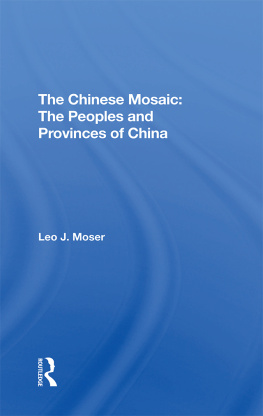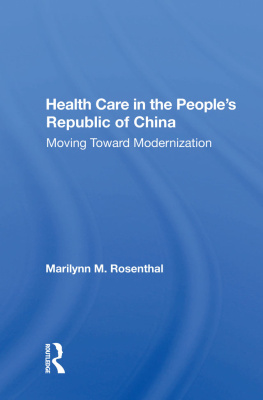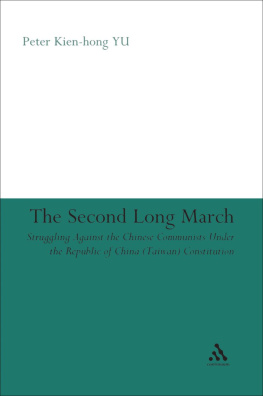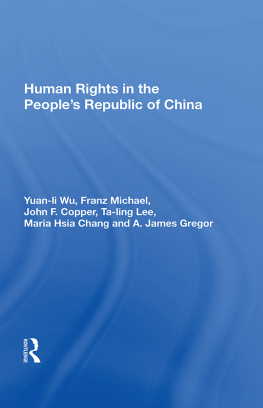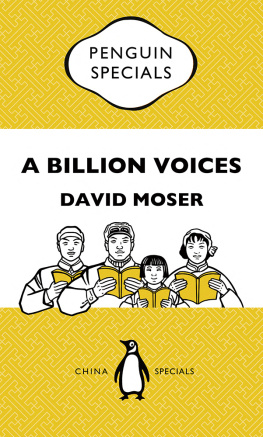The Chinese Mosaic
Also of Interest
China: The '80s Era, edited by Norton Ginsburg and Bernard A. Lalor
China as a Maritime Power, David G. Muller, Jr.
China's Cultural Heritage: The Ch'ing Dynasty, 1644-1912, Richard J. Smith
China Geographer, No. 12: The Environment, edited by Clifton W. Pannell and Christopher L. Salter
The Chinese Defense Establishment: Continuity and Change in the 1980s, edited by Paul H. B. Godwin
The Social Sciences and Fieldwork in China: Views from the Field, edited by Anne F. Thurston and Burton Pasternak
China's Financial System: The Changing Role of Banks, William Byrd
China's Economic Development: Growth and Structural Change, Chu-yuan Cheng
The Limits of Reform in China, edited by Ronald A. Morse
Economic Reform in the PRC: In Which China's Economists Make Known What Went Wrong, Why, and What Should Be Done About It, edited and translated by George C. Wang
China in World Affairs: The Foreign Policy of the PRC Since 1970, G. W. Choudhury
The Chinese Agricultural Economy, edited by Randolph Barker and Radha Sinha, with Beth Rose
China: A Political History, 1917-1980, fully revised and updated edition, Richard C. Thornton
Current Economic Problems in China, Xue Muqiao, edited and translated by K. K. Fung
Technology, Politics, and Society in China, Rudi Volti
China's Four Modernizations: The New Technological Revolution, edited by Richard Baum
Huadong: The Story of a Chinese People's Commune, Gordon Bennett
Painting in the People's Republic of China: The Politics of Style, Arnold Chang
Available in hardcover and paperback.
Westview Special Studies on East Asia
The Chinese Mosaic: The Peoples and Provinces of China
Leo J. Moser
Although the "Han" Chinese constitute about 95 percent of the population of the PRC, they are much more diverse than most Westerners realize. The numerous subgroups of Han speak dialects that seem almost like different languages, and they have a wide range of cultural traditions (differing cuisines, operatic forms, life styles, and attitudes toward authority, for example). This book presents an overview of the Han Chinese people, traces their historical and geographical backgrounds, and describes in detail the unique characteristics of each of the principal Han groups. Dr. Moser looks at the links in China between language and political culture and in the final chapters of the book addresses the topics of race, religion, and ethnicity; provincial stereotypes; folk culture; and how China has sought unity in diversity.
Leo J. Moser is a Foreign Service officer and currently the director of the Center for the Study of Foreign Affairs of the U.S. Department of State.
The Chinese Mosaic: The Peoples and Provinces of China
Leo J. Moser
First published 1985 by Westview Press, Inc.
Published 2019 by Routledge
52 Vanderbilt Avenue, New York, NY 10017
2 Park Square, Milton Park, Abingdon, Oxon OX14 4RN
Routledge is an imprint of the Taylor & Francis Group, an informa business
Copyright 1985 Taylor & Francis
All rights reserved. No part of this book may be reprinted or reproduced or utilised in any form or by any electronic, mechanical, or other means, now known or hereafter invented, including photocopying and recording, or in any information storage or retrieval system, without permission in writing from the publishers.
Notice: Product or corporate names may be trademarks or registered trademarks, and are used only for identification and explanation without intent to infringe.
ISBN 13: 978-0-367-29083-2 (hbk)
We classify more than a billion of the people who live on this planet as Chinese. If our species is to live together harmoniously in the future, this large proportion of our total numbers must be better understood by the rest. One of the major shortcomings in understanding the Chinese has been the tendency of Westerners and other outsiders to overlook the ethnic and subethnic diversity among the teeming populations of China. This book is designed to help fill that gap.
For a variety of reasons, some flowing from the attitudes of China's leaders since at least the Han dynasty, little attention has been given to the diversity within China. The stress has been on continuities over time and on the universality of the norms of behavior and customthe Great Traditionthat should be observed throughout the provinces. Although a great deal of raw material lies in provincial gazetteers ( fangzhi ), little of it has yet been subjected to the careful analysis of modern scholarship.
Reflecting this neglect, many Western works on China never even mention regional diversities within the Chinese people. Some may touch on the "non-Han" minorities of Chinathe Tibetans, Mongolians, and the likebut they seldom deal with the differences among the Han Chinese. In those works that do mention subethnic groups within the Han Chinese (or Sinitic) population, the reference is generally a fleeting one. For Chinese, the native place, or ancestral home ( yuanji ), is a major part of a person's perception of self, and the ties of clan, province, and dialect are often major factors in the individual's integration into national life. It is surprising that this aspect of Chinese reality has not been the topic of much systematic study.
The subjects to be covered in this book are by no means easy to address in the English language. A ready-made terminology does not exist in many cases, and it will thus be necessary to pause from time to time to clarify usage and even to coin a few much-needed terms.
To address the linguistic diversity among the Han Chinese, the various dialects will be described to some extent. This book is not, however, designed to be a definitive statement on the linguistics of the Sinitic world. Other works, some in English, do this more fully.
Transcription of Chinese words into the Roman alphabet, always a problem, becomes even more complicated when it is necessary to transcribe the dialects as well. In order to make the book accessible to the general reader, the scores of special symbols required to express the Sinitic dialects in the International Phonetic Alphabet (IPA) have not been introduced. Moreover, available data give the strong impression that the IPA has been applied in a variety of ways by the many linguists working on China's dialects. Some differences between sets of transcribed data surely reflect only the variant habits of transcribers.
To meet the objective of this book, the romanization currently employed in the People's Republic of China will be used for geographic and personal names and for the transcription of Chinese written characters in general. This system, the pinyin, cannot, however, be used to spell out dialectical material, for it relies on far too many new conventions. For dialectical material and other phonetic description, this book falls back on the long-standing Wade-Giles romanization, extending it as necessary for the dialects by adding letters from the roman alphabet. Voiced consonants, such as b-, d-, and g-, which do not exist in Standard Chinese but do exist in Wu and other vernaculars, are used as necessary. Aspiration is shown, as in Wade-Giles, by an apostrophe. Consequently, aspirated but voiced consonants can easily be shown by the series b'-, d'-, and g'-. The letter q is used for the glottal stop; a tilde over a vowel shows nasalization; the is pronounced as in Spanish. An unvoiced l- is shown by ll-, as in Welsh. This Wade-Giles extended romanization thus comes rather close to some forms of the IPA, although it must overlook many differences in vowel quality.


